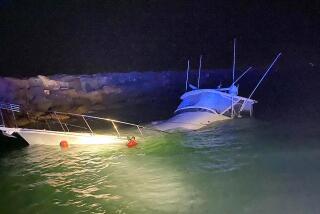Man Guilty in Boat Deaths; All Jurors Urge Leniency
- Share via
A man who crashed a boat into a concrete buoy in Seal Beach’s Anaheim Bay two years ago, killing five passengers, was found guilty Friday of involuntary manslaughter. Then, in a rare courtroom scene, the jury foreman rose and asked the judge, on behalf of all the jurors, for leniency.
“There has been enough suffering in this tragedy; no one gains by making this young man endure anything more,” jury foreman Cyrus Allen of Costa Mesa said later.
The guilty verdict--on all five of the manslaughter counts with which he was charged--was a shock to family and friends of the boat operator, 30-year-old Virl Earles of Seal Beach, who had come close to an acquittal at a previous trial in the case in January.
Earles appeared stunned when he heard the guilty verdict and cried continuously as he listened to the court clerk read the long verdict forms. He and his mother and grandmother had waited on a wooden bench outside the courtroom every day since the jury of six men and six women began deliberations Monday afternoon.
Judge Jean Rheinheimer, sitting in the Superior Court branch at Westminster, allowed Earles to remain free on his own recognizance until his sentencing Oct. 10.
The jurors’ request for leniency for Earles might make a difference, according to both prosecution and defense lawyers.
Involuntary manslaughter carries a penalty of two, four, or six years, but defendants can also request probation.
“I’ve never seen a better candidate for probation,” Earles’ attorney, Gary Pohlson, said. “What Virl has gone through these past couple of years is certainly punishment enough.”
Deputy Dist. Atty. John Conley said he did not know what kind of sentence he would recommend to Judge Rheinheimer but added that “the foreman’s request for leniency is in my mind.”
“We see the jury as the conscience of the community,” Conley said. “If the jurors think leniency is called for, I don’t think we can ignore that.”
Allen said the jurors felt after deciding on a verdict that something more should be done.
“Mr. Earles is a decent man; he did not intend to kill anybody,” Allen said.
The jury in Earles’ first trial had deadlocked 9 to 3 in favor of acquittal, forcing a mistrial. Earles’ supporters, including Pohlson, were surprised in view of that lopsided vote that prosecutors would even seek a second trial.
More Than ‘an Accident’
But Conley said he felt a responsibility to pursue the matter because “we believe what happened was something more than just an accident.”
Earles and eight others left Peter’s Landing in Huntington Harbour about 2 a.m. Oct. 28, 1984, in a borrowed, 20-foot power boat, for a cruise to see the Queen Mary in Long Beach.
On the return trip, just a few seconds after re-entering Anaheim Bay, Earles drove the boat into the 11-foot-wide Navy mooring buoy at a speed of no less than 25 m.p.h. Five people were killed instantly. Earles and the other three survivors were injured. Two of them climbed onto the buoy and held Earles’ head above the water as he lapsed in and out of consciousness. The fourth survivor, despite a broken pelvis, swam to shore for help.
Earles contended at both trials that when he re-entered the bay, a missing light at the end of the west jetty guarding the entrance threw him off course. He thought he was in the middle of the safe boating channel when in fact he was several hundred yards off course.
Negligence Claimed
Prosecutors contended that Earles knew the speed limit inside the bay was 5 m.p.h. and should have known that driving at five to six times that speed could be dangerous. Also, prosecutors said that because it was dark, and because his boat was overloaded and had no life jackets, Earles should have known that extra caution was needed.
The five killed were Anthony Sutton, 27, Ronald Myers, 22, and John Bakos, 22, all of Seal Beach; Kathy Weaver, 24, of Laguna Beach, and Patricia Hulings, 20, of Downey. The injured passengers were Ernest Chavez, Carol Kemble, and Stephen Brennan, all 26. All three testified that they did not consider Earles’ driving of the boat to be reckless.
Several family members and friends of some of the victims have attended Earles’ trials to give him moral support.
Conley put on virtually the same case this time that he did in the first trial, but with a few exceptions which the prosecutor believes may have made the difference.
After the first trial, Conley talked at length with some of the jurors, and discovered that they had some mistaken impressions about the conditions of the harbor on the night of the boat crash. Conley put on a few additional witnesses familiar with the bay’s conditions, and a new aerial photograph of the bay, to show that Earles should have been aware of the danger of the buoy.
Trying to Find a Way Out
Several of the jurors said the deliberations went on for so many days because they were trying to find a way to not convict Earles.
“We looked under every possible rug trying to find an alternative,” said juror Ed McCormack of Stanton.
Chavez, one of the boat’s survivors and a close friend of Earles, said after his own testimony last week that none of the four would ever be the same because of the tragedy.
“No matter what this jury does,” Chavez said then, “Virl is going to have to live with this the rest of his life.”
More to Read
Sign up for Essential California
The most important California stories and recommendations in your inbox every morning.
You may occasionally receive promotional content from the Los Angeles Times.













